“Water is life. It gives all of us a chance.”
These are the words of Science on the Fly (SOTF) co-founder John Le Coq, a lover of Earth’s rivers plus all of the scaled and finned creatures that call them home. There is a finite amount of water on this planet and “everything is intertwined with water,” Le Coq said, whether it be recreation, travel or national parks.
If water is the lifeblood, then rivers are the arteries that push that lifeblood across our living, breathing planet. Oceans are certainly paramount—after all, they cover 71% of the Earth’s surface and provide over half of all oxygen—but was there ever a creature that survived without its capillaries and veins?
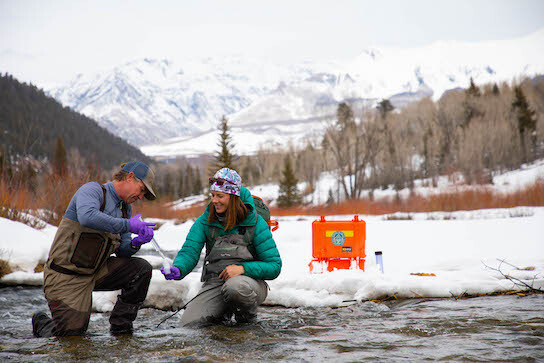
Water samples are collected each month by Science on the Fly's citizen scientists. These samples then get frozen and shipped to Woodwell Climate Research Center to get analyzed for nutrients and other organic compounds. Photo by Johnny Le Coq
Fishing for answers: The SOTF mission
Curiously named in the eyes of an outsider, Science on the Fly is a collaborative effort to study, understand and protect hundreds of rivers across the globe—over 400 in the lower 48 alone—through a team of unlikely contenders: flyfishers.
From Alaska to Costa Rica, Iceland to South America, SOTF volunteers are flyfishers who simply use a syringe to draw up a water sample once a month from their watershed of choice. After some basic filtering, that sample is then FedExed to a lab to be checked for phosphates, nitrogen levels, dissolved sediments and other statistics.
What the researchers learn from those numbers have a lot to do with climate change. Rivers, Le Coq told Kinute, are indicators of a shifting climate: water levels, temperature, biodiversity and chemical levels all point to the ways and the degrees that humans are impacting the climate.
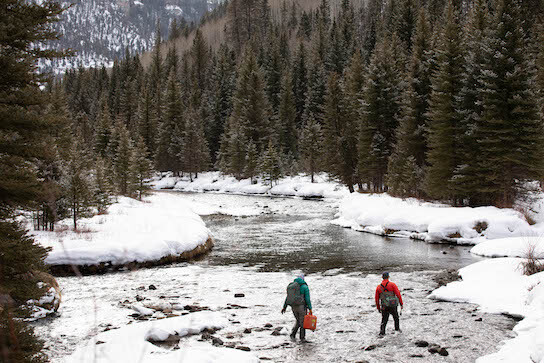
Volunteers from Telluride Angler are sampling the headwaters of the San Miguel River, a freestone river that flows 72 miles from Telluride to the confluence of the Dolores River. Photo by Johnny Le Coq
Le Coq is also CEO and founder of Fishpond USA, a flyfishing products company. After a couple of decades in the business of linking people who use water recreationally around the world, he saw an opportunity to contribute to scientific climate research in a unique way.
“As the CEO and founder of Fishpond, I have learned how to use my voice as an owner of a company more responsibly than just trying to make profits,” Le Coq said.
He pictured his business working with policymakers, fisherpeople and different environmental organizations.
“The most important part of how SOTF came about is my keen interest in climate change, how species around the world are impacted by our decisions and how biodiversity gets impacted by climate change, pollution and plastics," he said.
At a climate change meeting attended by many other business executives from all sorts of industries—even the founders of Ben and Jerry’s Ice Cream were reportedly there—where CEOs discussed how they could incorporate climate communication into their business models, Le Coq bumped into Max Holmes, a representative of the world-renowned Woodwell Climate Research Center. After bonding over flyfishing, Holmes and Le Coq quickly realized that they were like-minded in the goal to preserve the planet’s most precious commodity: water. A couple of chapters later, SOTF was founded.
The duo discovered that they were onto something: the threshold of insanely cost-prohibitive water studies (which can run millions of dollars per year to execute) can be lowered by recruiting people who are already on the water in the first place. Flyfishers, for example, often travel to the most remote rivers of the world. In the name of their passion for the sport, these volunteers take a few seconds out of their fishing excursion to package some water and send it to the Woodwell research center in Massachusetts.
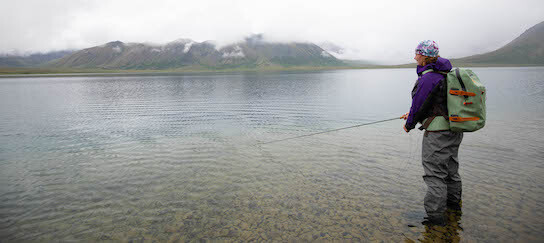
Science on the Fly member, Allie Cunningham, fishing the Kisaralik Lake in the Kilbuk Mountains of Alaska. Photo by Johnny Le Coq
Let’s talk about trout: An apolitical approach to climate change and fishing
It’s no secret that climate change action is a more popular agenda item for Democratic legislators and voters than Republican ones. The volunteers who contribute to SOTF, however, are red, blue, purple and everything in-between; the reason for that, Le Coq explained, is that the SOTF network is not connected by a common political motive. It’s connected by their respect for rivers.
Grandfathers teaching their grandchildren how to bait hooks, the family dog chasing a stick thrown out into the water, a pontoon full of friends lazing down the current--precious memories for so many people are connected by one commonality: they all happen between the banks of a river. No lifestyle is independent of the American watershed. That alone makes their waters worth fighting for no matter your ballot choices, Le Coq said, but the consequence of poor river health is still so much greater.
Over 640 million acres of public land, national parks and forestry reserves in America are impacted by rivers. Vegetation, insects and animals have a huge stake in the watershed system. The Colorado River alone is responsible for the drinking water of 40 million people. Seven downstream states depend on the Colorado.
Earlier this year, 140 miles of the Colorado River were shut down to recreational use because water temperatures got too warm; this can have a fatal outcome for the rivers’ fish and other wildlife. Water temperatures get too warm when the river experiences drought conditions, overconsumption leading to low water levels, and many other factors.
Tourism and leisure industries aren’t immune; outdoor recreation is a huge sector in the U.S. economy, generating over $800 billion in spending a year, so the Colorado River closure likely stung many. If the other harms done by changing river conditions don’t talk, the money certainly should.
“These water systems are critical to people’s personal lives. How people are looking at the impact on their lifestyle is profound, not only from an economic perspective,” Le Coq said. "It’s changing people’s lifestyles in all sorts of major ways.”
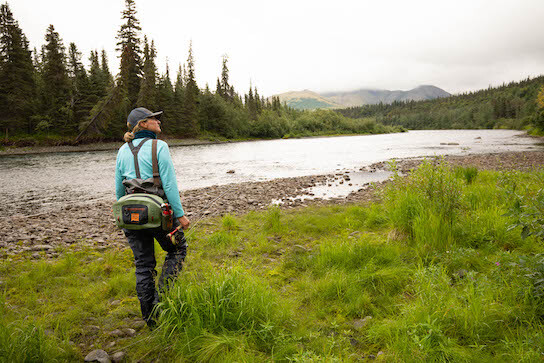
Allison Oliver, an Aquatic Ecologist and Biogeochemist, heading out to fly fish the Kisaralik River. Photo by Johnny Le Coq
A drop in the ocean: Taking small steps on a long journey
Leaders in the oil, gas and renewable industry are abuzz with conversation on carbon emission reduction, renewable natural gas and livestock methane capture. On the smaller scale, Le Coq says more people from all political standpoints are beginning to realize that carbon in the atmosphere is, in fact, heating up the planet. SOTF seeks to unify the hikers in Yosemite, the fishermen in Alabama and the indigenous anglers in Alaska with one common goal.
“One thing we have in common is our love for the outdoors. No matter where you are in the world, whether it is an urban corridor or the boondocks, the natural world is a gift,” Le Coq said. “So let’s not kick it in the ass.”
With how rapidly recent climate change has occurred, comparable norms from throughout history are no longer comparable. That is why SOTF is trying to draw attention to the findings of their data in Washington.
“Using the force of the flyfishing industry and thousands of people who love this sport, we have access now with people in policy positions in federal, state and local government levels that can understand our world. They understand why they should care about rivers,” Le Coq explained.
Getting policymakers on board is the tip of the iceberg. The causes of river change are scattered yet tangled, unrelated yet a consequence of the other, a murk of cause and effect.
The Colorado River is a good example of this. The river is dependent on mountain snow melting and rain for water, but drought conditions drop river levels substantially, causing warming. The Colorado became a mere trickle this summer and shut down an entire industry. From 2020 to 2021, hundreds of thousands of acres in Colorado burned due to the drought conditions; the wildfires stripped the land of vegetation and, without the hold of roots, the state was pummeled by mudslides when it eventually rained. Those mudslides deposited copious amounts of settlement and runoff downstream, disrupting the water and ecosystems. Disrupted water flow and ecosystems led again to river closures, low water levels, high water temperatures and fish mortality.
Some watershed problems can’t be traced back to anything at all. For example, the salmon spawning ground in Bristol Bay, Alaska saw unprecedented, record-breaking numbers of sockeye salmon get upstream and spawn this year.
But just on the other side of the mountains near the City of Bethel and the Kuskokwim River, there were record lows of chum and Chinook salmon coming through the rivers. Salmon had to be shipped in just to feed indigenous peoples in the area who’ve depended on salmon for generations and, despite intensive studies across over 100 miles of Alaskan rivers, SOTF still can’t pinpoint why either of these phenomena occurred.
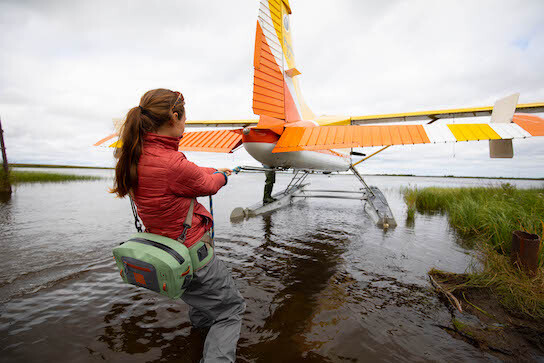
Science on the Fly partners with Fishpond and Papa Bear Adventures, an outfitter in Alaska that helps to transport groups to the headwaters of the wild and vulnerable rivers within the Yukon-Kuskokwim Delta watershed. Photo by Johnny Le Coq
The cost of change: Climate action is expensive
Meanwhile, on the other side of the planet, the water crisis in Chennai, the capital city of India, tells a different story. Water had to be imported as millions of people were going without the necessity. While this shows that serious infrastructure and manufacturing investments need to be made in the area to support it, the crisis also came as a cautionary tale to investors that funding the area is too risky or unstable.
The climate costs in more ways than people may realize. For example, a municipal school bond in a district like Houston, Texas is likely to be more expensive than one in perhaps the upper Midwest; Houston is impacted by more extreme weather events, like flooding and hurricanes, which have only gotten more extreme as climate change progresses.
“We're creating this dialogue to get people to be informed,” Le Coq said. “It’s about economic opportunity, because people don't change unless it's about economics. That's the bottom line. If there's money in it, people start to put time and effort into it, and there can be change and innovation of renewables, innovation of new industries.”
SOTF must spend about $50,000 a month to maintain its own sampling operation. Each sample costs about $100 from shipping to analysis, which only amounts to a few hundreds of thousands a year to sample 400-some rivers. A study by the Great Rivers Observatory doing the exact same thing in Siberia and northern Russia, on the other hand, expends millions to analyze the waters of just 20 rivers. The SOTF operation is incredibly efficient, and Le Coq said that other organizations may adopt the approach soon.
“We’re creating science on a level that’s unprecedented, as far as how science organizations go out and get this data. We’re using volunteers on a huge scale," he said.
Small fish, big pond: The SOTF team
SOTF started as a small group with an even smaller budget. It now plans to be monitoring rivers in all 50 states by the end of the year.
Every river has a different story, written by its geographical location, source, biodiversity and the way people use its waters.
“Every river has a specific story, not only from a chemistry perspective, but a personality,” Le Coq said. “... There’s just this core value of adventure, life, beauty, grace. (Rivers) personify this need to be aware of our shifting temperatures and hopefully spark a solution to innovation.”
SOTF targets a core audience of people—those who use rivers for recreational activity—to create a community-based science platform and “together, collaboratively, make a difference,” Le Coq said.
“If you love flyfishing, or just love being outdoors, hunting, whatever it is you do, you should love this biodiversity that comes from water,” he continued. “Whether you fish rivers or not, you can get behind it to say it’s important because the natural world is part of life so we should protect that.”
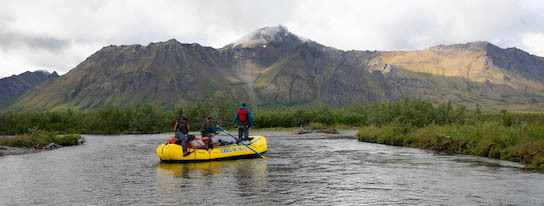
Allie Cunningham, Director of Science on the Fly, collecting a water sample from the Kisaralik River in Alaska. Each sample gets pushed through a .22 micron filter which removes bacteria, microorganisms, and other suspended solids. Photo by Johnny Le Coq
On a professional scale, Le Coq’s goals include getting people to pay notice to watersheds, using data to encourage a policy shift to more renewables and carbon reduction, and planning for a sustainable future. On a personal scale, he hopes to float a lot more rivers.
His team is still small, but they have fun doing what they do, Le Coq said. He is joined by co-founder Max Holmes who is now executive director at the Woodwell Climate Research Center, volunteer coordinator and social media manager Allie Cunningham, filmmaker Stash Wislocki, graphic designer Stephen Rockwood and a team of experts from Woodwell.
To get involved with SOTF either as a volunteer or a financial supporter, visit scienceonthefly.org.
Le Coq says there is this unbreakable “link in life,” connecting humans, the planet and those we share it with. Water is the chain binding it all together: the water we drink now is the same rain that fell on the shoulders of Captain John Parker at the Battle of Lexington, the same river-water that cooled the feet of ancient pharaohs when they came to the Nile, the same water that Lewis and Clark navigated in the Northwest Passage, even the same pond that gave drink to dinosaurs millions of years before us.
With a resource so precious also being so finite—and so vulnerable—being a river steward has never been more important.
“Every drop of water that we have on Earth today is the same exact water that was here millions and millions of years ago,” Le Coq said. “We’ve never made new water and we never will. No matter what, it doesn’t disappear. It just goes to a different form or a different place. That is why we take care of it. It’s not about flyfishing, it’s about using flyfishing as a way to study these rivers that impact so many.”
